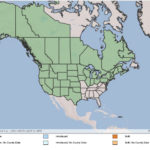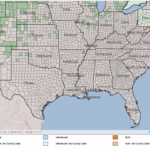Sagittaria cuneata
USDA, NRCS. 2018. The PLANTS Database (http://plants.usda.gov, 28 March 2018). National Plant Data Team, Greensboro, NC 27401-4901 USA.
Illustration: USDA-NRCS PLANTS Database / Britton, N.L., and A. Brown. 1913. An illustrated flora of the northern United States, Canada and the British Possessions. 3 vols. Charles Scribner’s Sons, New York. Vol. 1: 99.
What Is Arumleaf Arrowhead?
Other common spellings and names include: narrowleaf arrowhead.
Physical Characteristics
Leaves:
- Straight or spreading straight
- Leaf blades triangular or egg-shaped
- Arrowhead shaped
- Portion above the base lobes up to 6 inches long & 8 inches wide
Flowers:
- Stamen have fleshy, slendy filaments
- Stamen same length as anthers
- Up to 0.59 inches in diameter
- Bloom Jun – Sep
Fruit:
- Egg-shaped
- Up to 0.09 inches long & 0.08 inches wide
- Faces usually with low, narrow ridge
Stem:
- Straight or arching
- Simple, sometimes branching
- Main axis can have up to 7 whorls
- Bracts egg- or sword-shaped, up to 0.78 inches long
Where Does it Grow?
Arumleaf arrowhead can be found along rivers and streams.
Pros and Cons of Arrowhead
The tubers of arrowheads are prized foods by ducks, geese, muskrats, and nutria. Seeds are sometimes consumed by ducks. Submerged portions of all aquatic plants provide habitats for many micro and macro invertebrates. These invertebrates in turn are used as food by fish and other wildlife species (e.g. amphibians, reptiles, ducks, etc.). After aquatic plants die, their decomposition by bacteria and fungi provides food (called “detritus”) for many aquatic invertebrates.


